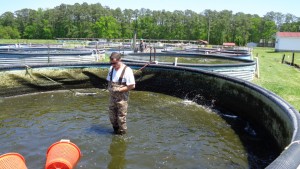According to the Monterey Bay Aquarium Seafood Watch, the hybrid striped bass is an overall good choice of seafood. In a list of criteria that includes effluent (liquid waste), habitat, chemicals, escapes, disease, source, wildlife mortalities, and introduced species escapes, the hybrid striped bass received a grade of green for both pond and Recirculating Aquaculture Systems production.
Recirculating Aquaculture Systems (RASs) and low-water-exchange ponds have low discharge of effluent into the environment. The aquaculture ponds are drained infrequently because there is small concern about diseases that could be transferred to wild fish stocks.
RASs tend to use less water than ponds, therefore needing not only less water, but less chemicals to treat the water to make sure it is free from algae, unwanted plants, and bacteria.
The main issue surrounding the production of the hybrid striped bass and sustainability is the level of fishmeal and oil used in feeds. The level of concern for this is moderate. However, it must be noted that any specific feed ingredient specific to hybrid striped bass was difficult to find. The industry and general population would benefit with a greater transparency in disclosing feed ingredients.
Fish feed needs to be cost effective while significantly increasing and influencing fish growth, product quality, and body composition. Fish feed is also the largest cost factor in an aquafarm. It can generally constitute 40 to 60 percent of variable costs in fish production. However, the ingredients of fish feed can vary depending on aquaculture farm and stage of development. Fish feed needs to be high in protein and contain carbohydrates. Fish feed can contain anything from soybean meal, low temperature processed menhaden meal, regular menhaden fish meal, anchovy meal, meat and bone meal, poultry by-product meal, or cottonseed meal.
Generally, sustainable fishery sources are used in the production of hybrid striped bass feed. Most of the fishmeal and fish oil used in hybrid striped bass feeds come from the Gulf menhaden fishery. Gulf menhaden fishery is not overfished.


